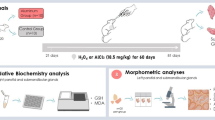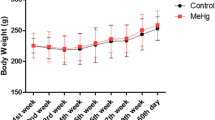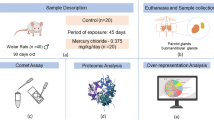Abstract
This study aimed to investigate the effects of lead (Pb) exposure on parotid and submandibular glands through morphological aspects as well as the systemic and salivary gland redox state. Male Wistar rats were exposed to 50 mg/kg/day of Pb-acetate or distilled water by intragastric gavage for 55 days (n = 40). Blood samples were used for lipid peroxidation (LPO), glutathione (GSH), and trolox equivalent antioxidant capacity (TEAC) assays. Samples of salivary glands were analyzed by LPO, nitrites (NO), and antioxidant capacity against peroxyl radicals (ACAP) levels. Morphometric analyses (total stromal area [TSA], total parenchyma area [TPA], total ductal area [TDA], and total acinar area [TAA]) and immunohistochemistry for cytokeratin-19 (CK-19), metallothionein I/II (MT I/II), and anti-smooth muscle actin (α-SMA) were performed. The results revealed that exposure to Pb triggered systemic oxidative stress represented by lower GSH levels and increased TBARS/TEAC ratio in blood plasma. ACAP was reduced, while NO and LPO were increased in both parotid and submandibular. The morphological analyses showed increase on MT I/II expression, reduced CK-19 expression in both glands, and α-SMA reduced the immunostaining only in the parotid glands. The morphometric analyses revealed an increase in TPA in both glands, while TAA was reduced only in submandibular glands and TDA was increased only in parotid glands. Our findings are pioneer in showing that long-term exposure to Pb is able to promote blood and glandular oxidative stress associated with cellular, morphological, and biochemical damage in both parotid and submandibular glands.








Similar content being viewed by others
Data availability
The data used to support the results of the present research work are accessible and can be obtained from the corresponding author on demand.
References
Abdollahi M, Dehpour A-R, Fooladgar M (1997) Alteration of rat submandibulary gland secretion of protein, calcium and N-acetyl-β-D-glucosaminidase activity by lead. Gen Pharmacol Vasc S 29:675–680
Abdollahi M, Fooladian F, Emami B, Zafari K, Bahreini-Moghadam A (2003) Protection by sildenafil and theophylline of lead acetate-induced oxidative stress in rat submandibular gland and saliva. Hum Exp Toxicol 22:587–592
Amado LL, Garcia ML, Ramos PB, Freitas RF, Zafalon B, Ferreira JLR, Yunes JS, Monserrat JM (2009) A method to measure total antioxidant capacity against peroxyl radicals in aquatic organisms: application to evaluate microcystins toxicity. Sci Total Environ 407:2115–2123
Angelieri F, de Oliveira GR, Sannomiya EK, Ribeiro DA (2007) DNA damage and cellular death in oral mucosa cells of children who have undergone panoramic dental radiography. Pediatr Radiol 37:561–565
Aragao W, da Costa N, Fagundes N, Silva M, Alves-Junior S, Pinheiro J, Amado L, Crespo-López M, Maia C, Lima R (2017) Chronic exposure to inorganic mercury induces biochemical and morphological changes in the salivary glands of rats. Metallomics 9:1271–1278
Balachander N, Masthan KM, Babu NA, Anbazhagan V (2015) Myoepithelial cells in pathology. J Pharm Bioallied Sci 7:S190–S193
Bittencourt LO, Puty B, Charone S, Aragão WAB, Farias-Junior PM, Silva MCF, Crespo-Lopez ME, Leite AdL, Buzalaf MAR, Lima RR (2017): Oxidative biochemistry disbalance and changes on proteomic profile in salivary glands of rats induced by chronic exposure to methylmercury Oxidative medicine and cellular longevity 2017
Blaschke AJ, Weiner JA, Chun J (1998) Programmed cell death is a universal feature of embryonic and postnatal neuroproliferative regions throughout the central nervous system. J Comp Neurol 396:39–50
Bohl L, Merlo C, Carda C, Gómez de Ferraris ME, Carranza M (2008) Morphometric analysis of the parotid gland affected by alcoholic sialosis. J Oral Pathol Med 37:499–503
Bradford MM (1976) A rapid and sensitive method for the quantitation of microgram quantities of protein utilizing the principle of protein-dye binding. Anal Biochem 72:248–254
Burgess LK, Dardick I (1998) Cell population changes during atrophy and regeneration of rat parotid gland. Oral Surg Oral Med Oral Pathol Oral Radiol Endod 85:699–706
Campana O, Sarasquete C, Blasco J (2003) Effect of lead on ALA-D activity, metallothionein levels, and lipid peroxidation in blood, kidney, and liver of the toadfish Halobatrachus didactylus. Ecotoxicol Environ Saf 55:116–125
Cherian MG, Jayasurya A, Bay B-H (2003) Metallothioneins in human tumors and potential roles in carcinogenesis. Mutat Res Fundam Mol Mech Mutagen 533:201–209
Christie NT, Costa M (1984) In vitro assessment of the toxicity of metal compounds. Biol Trace Elem Res 6:139–158
da Costa NM, Correa RS, Júnior IS, Figueiredo AJ, Vilhena KF, Farias-Junior P, Teixeira FB, Ferreira NM, Pereira-Júnior JB, Dantas KDGF (2014) Physical, chemical, and immunohistochemical investigation of the damage to salivary glands in a model of intoxication with aluminium citrate. Int J Environ Res Public Health 11:12429–12440
Daggett DA, Oberley TD, Nelson SA, Wright LS, Kornguth SE, Siegel FL (1998) Effects of lead on rat kidney and liver: GST expression and oxidative stress. Toxicology 128:191–206
Dardick I, Burford-Mason AP, Garlick DS, Carney WP (1992) The pathobiology of salivary gland. Virchows Archiv A 421:105–113
de Almeida GRC, de Freitas Tavares CF, de Souza AM, de Sousa TS, Funayama CAR, Barbosa F Jr, Tanus-Santos JE, Gerlach RF (2010) Whole blood, serum, and saliva lead concentrations in 6-to 8-year-old children. Sci Total Environ 408:1551–1556
de Souza Guerra C, Magna GAM, Machado SL, De Capitani EM, Ramos J, Peixoto ITA, Peixoto AAA, Moreno MLV, Alva JCR, Nakadi FV (2015) Lead concentrations in whole blood, serum, saliva and house dust in samples collected at two time points (12 months apart) in Santo Amaro, BA, Brazil. Environ Res 142:337–344
de Souza ID, de Andrade AS, Dalmolin RJS (2018) Lead-interacting proteins and their implication in lead poisoning. Crit Rev Toxicol 48:375–386
Ellman GL (1959) Tissue sulfhydryl groups. Arch Biochem Biophys 82:70–77
Ercal N, Gurer-Orhan H, Aykin-Burns N (2001) Toxic metals and oxidative stress part I: mechanisms involved in metal-induced oxidative damage. Curr Top Med Chem 1:529–539
Esterbauer H, Cheeseman KH (1990): [42] Determination of aldehydic lipid peroxidation products: malonaldehyde and 4-hydroxynonenal, Methods in enzymology. Elsevier, pp. 407-421
Fagundes NCF, Fernandes LMP, de Oliveira Paraense RS, de Farias-Junior PMA, Teixeira FB, Alves-Junior SM, de Jesus Viana Pinheiro J, Crespo-López ME, Maia CSF, Lima RR (2016) Binge drinking of ethanol during adolescence induces oxidative damage and morphological changes in salivary glands of female rats. Oxidative Med Cell Longev 2016:1–11
Farias-Junior PMA, Teixeira FB, Fagundes NCF, Miranda GHN, Bittencourt LO, de Oliveira Paraense RS, Silva MCF, Santo Sagica FE, de Oliveira EH, Crespo-López ME (2017) Chronic intoxication by methylmercury leads to oxidative damage and cell death in salivary glands of rats. Metallomics 9:1778–1785
Faustino SES, Stipp ACM (2003) Efeitos do alcoolismo crônico e da desintoxicação alcóolica sobre a glândula submandibular de ratos: estudo morfométrico. J Appl Oral Sci 11:21–26
Fernandes L, Teixeira FB, Alves-Junior S, Pinheiro JJ, Maia CSF, Lima RR (2015) Immunohistochemical changes and atrophy after chronic ethanol intoxication in rat salivary glands. Histol Histopathol 30:1069–1078
Ferreira-Cravo M, Piedras FR, Moraes TB, Ferreira JLR, de Freitas DPS, Machado MD, Geracitano LA, Monserrat JM (2007) Antioxidant responses and reactive oxygen species generation in different body regions of the estuarine polychaeta Laeonereis acuta (Nereididae). Chemosphere 66:1367–1374
Ghazi-Khansari M, Mortazapour Z, Shayaganfar N, Abdollahi M, Dehpour AR (1997) Lead determination in parotid and submandibular salivas and whole blood in rat. Toxic Subst Mech 16:327–335
Gillis BS, Arbieva Z, Gavin IM (2012) Analysis of lead toxicity in human cells. BMC Genomics 13:344
Gleichmann M, Mattson MP (2011) Neuronal calcium homeostasis and dysregulation. Antioxid Redox Signal 14:1261–1273
Green L, Fisher EB, Perlow S, Sherman L (1981): Preference reversal and self control: choice as a function of reward amount and delay. Behaviour Analysis Letters
Gu H, Robison G, Hong L, Barrea R, Wei X, Farlow MR, Pushkar YN, Du Y, Zheng W (2012) Increased β-amyloid deposition in Tg-SWDI transgenic mouse brain following in vivo lead exposure. Toxicol Lett 213:211–219
Halmo L, Nappe TM (2019): Lead toxicity
Hengartner MO (2000) The biochemistry of apoptosis. Nature 407:770–776
Islas-Granillo H, Borges-Yáñez A, Fernández-Barrera MÁ, Ávila-Burgos L, Patiño-Marín N, de Lourdes Márquez-Corona M, Mendoza-Rodríguez M, Medina-Solís CE (2017) Relationship of hyposalivation and xerostomia in Mexican elderly with socioeconomic, sociodemographic and dental factors. Sci Rep 7:1–8
Kasperczyk S, Dobrakowski M, Kasperczyk J, Ostałowska A, Zalejska-Fiolka J, Birkner E (2014) Beta-carotene reduces oxidative stress, improves glutathione metabolism and modifies antioxidant defense systems in lead-exposed workers. Toxicol Appl Pharmacol 280:36–41
Kelada SN, Shelton E, Kaufmann RB, Khoury MJ (2001) δ-Aminolevulinic acid dehydratase genotype and lead toxicity: a HuGE review. Am J Epidemiol 154:1–13
Kharoubi O, Slimani M, Aoues A (2011) Neuroprotective effect of wormwood against lead exposure. J Emerg Trauma Shock 4:82–88
Koh DH, Locke SJ, Chen YC, Purdue MP, Friesen MC (2015) Lead exposure in US worksites: a literature review and development of an occupational lead exposure database from the published literature. Am J Ind Med 58:605–616
Kosnett M (2003) Intoxicação por metais pesados e quelantes. Farmacologia básica e Clínica:867–870
Lead WI (1995) Environmental health criteria 165. International Programme on Chemical Safety. World Health Organization, Geneva
Lima LAO, Bittencourt LO, Puty B, Fernandes RM, Nascimento PC, Silva MCF, Alves-Junior SM, Pinheiro JJV, Lima RR (2018) Methylmercury intoxication promotes metallothionein response and cell damage in salivary glands of rats. Biol Trace Elem Res 185:135–142
Lu J, Jin T, Nordberg G, Nordberg M (2005) Metallothionein gene expression in peripheral lymphocytes and renal dysfunction in a population environmentally exposed to cadmium. Toxicol Appl Pharmacol 206:150–156
Maruyama CL, Monroe M, Hunt J, Buchmann L, Baker OJ (2019) Comparing human and mouse salivary glands: a practice guide for salivary researchers. Oral Dis 25:403–415
Mese H, Matsuo R (2007) Salivary secretion, taste and hyposalivation. J Oral Rehabil 34:711–723
Miller NJ, Rice-Evans C, Davies MJ, Gopinathan V, Milner A (1993) A novel method for measuring antioxidant capacity and its application to monitoring the antioxidant status in premature neonates. Clin Sci 84:407–412
Mitra P, Sharma S, Purohit P, Sharma PJ (2017) Clinical and molecular aspects of lead toxicity: an update. Crit Rev Clin Lab Sci 54:506–528
Needleman H (2004) Lead poisoning. Annu Rev Med 55:209–222
Obeng-Gyasi E (2019) Sources of lead exposure in various countries. Rev Environ Health 34:25–34
Oliveira AC, Pereira MC, Santana LN, Fernandes RM, Teixeira FB, Oliveira GB, Fernandes LM, Fontes-Júnior EA, Prediger RD, Crespo-López ME (2015) Chronic ethanol exposure during adolescence through early adulthood in female rats induces emotional and memory deficits associated with morphological and molecular alterations in hippocampus. J Psychopharmacol 29:712–724
Patrick L (2006): Lead toxicity, a review of the literature. Part I: exposure, evaluation, and treatment. Alternative medicine review 11
Pedersen MØ, Larsen A, Stoltenberg M, Penkowa M (2009) The role of metallothionein in oncogenesis and cancer prognosis. Prog Histochem Cytochem 44:29–64
Percário S, Moreira DR, Gomes BA, Ferreira ME, Gonçalves ACM, Laurindo PS, Vilhena TC, Dolabela MF, Green MD (2012) Oxidative stress in malaria. Int J Mol Sci 13:16346–16372
Qu W, Diwan BA, Liu J, Goyer RA, Dawson T, Horton JL, Cherian MG, Waalkes MP (2002) The metallothionein-null phenotype is associated with heightened sensitivity to lead toxicity and an inability to form inclusion bodies. Am J Pathol 160:1047–1056
Rabinowitz MB, Wetherill GW, Kopple JD (1976) Kinetic analysis of lead metabolism in healthy humans. J Clin Invest 58:260–270
Re R, Pellegrini N, Proteggente A, Pannala A, Yang M, Rice-Evans C (1999) Antioxidant activity applying an improved ABTS radical cation decolorization assay. Free Radic Biol Med 26:1231–1237
Redder CP, Kandagal VS, Vibhute N, Ingaleshwar PS, Shetty SJ, Ahamad S (2013) Myoepithelial cells: current perspectives in salivary gland tumors. Clin Cancer Investigat J 2:101
Schmitt CJ, Whyte JJ, Roberts AP, Annis ML, May TW, Tillitt DE (2007) Biomarkers of metals exposure in fish from lead-zinc mining areas of southeastern Missouri, USA. Ecotoxicol Environ Saf 67:31–47
Sengupta P (2013) The laboratory rat: relating its age with human’s. Int J Prev Med 4:624
Seven A, Guzel S, Seymen O, Civelek S, Uncu M (2004) Effects of vitamin E supplementation on oxidative stress in streptozotocin induced diabetic rats: investigation of liver and plasma. Yonsei Med J 45:703–710
Shraideh Z, Badran D, Hunaiti A, Battah A (2018) Association between occupational lead exposure and plasma levels of selected oxidative stress related parameters in Jordanian automobile workers. Int J Occup Med Environ Health 31:517–525
Simons T (1986) Passive transport and binding of lead by human red blood cells. J Physiol 378:267–286
Staff JF, Harding A-H, Morton J, Jones K, Guice EA, McCormick T (2014) Investigation of saliva as an alternative matrix to blood for the biological monitoring of inorganic lead. Toxicol Lett 231:270–276
Stenvinkel P (2003) Anaemia and inflammation: what are the implications for the nephrologist? Nephrol Dial Transplant 18:viii17–viii22
Timchalk C, Lin Y, Weitz KK, Wu H, Gies RA, Moore DA, Yantasee W (2006) Disposition of lead (Pb) in saliva and blood of Sprague-Dawley rats following a single or repeated oral exposure to Pb-acetate. Toxicology 222:86–94
Tom M, Chen N, Segev M, Herut B, Rinkevich B (2004) Quantifying fish metallothionein transcript by real time PCR for its utilization as an environmental biomarker. Mar Pollut Bull 48:705–710
Toscano CD, Guilarte TR (2005) Lead neurotoxicity: from exposure to molecular effects. Brain Res Rev 49:529–554
Tsaih S-W, Schwartz J, Lee M, Amarasiriwardena C, Aro A, Sparrow D, Hu H (1999) The independent contribution of bone and erythrocyte lead to urinary lead among middle-aged and elderly men: the normative aging study. Environ Health Perspect 107:391–396
Vallee BL, Ulmer DD (1972) Biochemical effects of mercury, cadmium, and lead. Annu Rev Biochem 41:91–128
Wang L, Chen D, Wang H, Liu Z (2009) Effects of lead and/or cadmium on the expression of metallothionein in the kidney of rats. Biol Trace Elem Res 129:190–199
Wani A, Ara A, Usmani J (2015) Lead toxicity: a review. Interdiscip Toxicol 8:55–64
Warrington NM, Zhu G, Dy V, Heath AC, Madden PA, Hemani G, Kemp JP, Mcmahon G, St Pourcain B, Timpson NJ (2015) Genome-wide association study of blood lead shows multiple associations near ALAD. Hum Mol Genet 24:3871–3879
Acknowledgments
We thank the Amazônia Foundation for Support to Studies and Research (FAPESPA) and National Council for Scientific and Technological Development (CNPq).
Funding
This study was financed in part by the Coordenação de Aperfeiçoamento de Pessoal de Nível Superior – Brasil (CAPES) – Finance Code 001.
Author information
Authors and Affiliations
Contributions
Conceptualization: Rafael Rodrigues Lima and Géssica de Oliveira Lopes; methodology: Rafael Rodrigues Lima, Géssica de Oliveira Lopes, Walessa Alana Bragança Aragão, Luana Leão, João de Jesus Viana Pinheiro, Sergio Melo Alves-Junior, Maria Elena Crespo-Lopez; formal analysis and investigation: Géssica de Oliveira Lopes, Luana Leão, João de Jesus Viana Pinheiro, Priscila Cunha Nascimento, Leonardo Oliveira Bittencourt; writing—original draft preparation: Géssica de Oliveira Lopes and Walessa Alana Bragança Aragão; writing—review and editing: Rafael Rodrigues Lima, João de Jesus Viana Pinheiro, Maria Elena Crespo-Lopez; funding acquisition: Rafael Rodrigues Lima; resources: Rafael Rodrigues Lima; supervision: Rafael Rodrigues Lima.
Corresponding author
Ethics declarations
Conflict of interest
The authors declare that they have no conflict of interest.
Ethical approval
All procedures were previously approved by the Ethics committee on animal experimentation by Federal University of Para (2237110716 - CEPAE-UFPA) following the guidelines suggested by NIH Guide to Care and Use of Laboratory Animals.
Consent to participate
We confirm that the manuscript has been read and approved by all named authors and that there are no other persons who satisfied the criteria for authorship but are not listed. We further confirm that the order of authors listed in the manuscript has been approved by all of us.
Consent to publish
We confirm that we have given due consideration to the protection of intellectual property associated with this work and that there are no impediments to publication, including the timing of publication, with respect to intellectual property. In so doing, we confirm that we have followed the regulations of our institutions concerning intellectual property.
Additional information
Responsible Editor: Mohamed M. Abdel-Daim
Publisher’s note
Springer Nature remains neutral with regard to jurisdictional claims in published maps and institutional affiliations.
Rights and permissions
About this article
Cite this article
Lopes, G.d., Aragão, W.A.B., Nascimento, P.C. et al. Effects of lead exposure on salivary glands of rats: insights into the oxidative biochemistry and glandular morphology. Environ Sci Pollut Res 28, 10918–10930 (2021). https://doi.org/10.1007/s11356-020-11270-5
Received:
Accepted:
Published:
Issue Date:
DOI: https://doi.org/10.1007/s11356-020-11270-5




